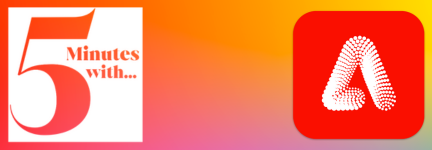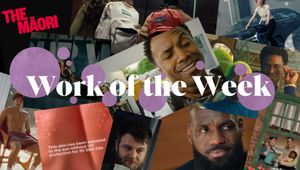
5 Minutes with… Andy Silva

Andy Silva is a managing partner at LA-based creative agency Party Land. Starting his career in his native New Zealand, he then moved stateside with a six-year stint at 72andSunny, where he met and forged a lasting relationship with Party Land co-founder and CCO, Matt Heath.
After gaining some experience at telecoms giant AT&T, as part of the brand’s internal creative services team, Andy joined his former colleague at Party Land, where they are focused on becoming “the number one comedy agency in the US.” Choosing to work alongside brands that are willing to break the conventions of their genres, Andy and his team have created humorous campaigns for the likes of Dave's Hot Chicken, Twitch, Liquid Death, Google, Netflix, Wholly Veggie and more.
LBB’s Ben Conway caught up with Andy to discuss his journey from Auckland to adland, how he got back on the horse after an unsuccessful eight months at his first creative role, and finding clients “who are brave enough to say ‘yes’ to an idea that scares them a bit.”
LBB> What creative content inspired or interested you most when you were growing up?
Andy> One of my more vivid memories growing up in New Zealand was when we got a third TV channel (aptly named Channel 3), so content was a little scant in my early years. Yes, we were served all the great movies from the US (only two years later) and yes, I watched my best friend’s brother’s dubbed VHS of Terminator 2 and Wayne’s World every day for a year. But truth be told, and not to pander to the assignment, I really loved ads, especially funny ads.
In my not-so-humble opinion, New Zealand is one of the strongest advertising markets in the world. Budgets can often be tight, so when you can’t rely on big set builds, SFX and other bigger budget opportunities, you lean into great ideas and compelling storytelling to drive consideration. There are ads I can still recite by heart and if you throw a catchphrase like ‘bugger’, ‘good on ya mate’ or ‘the milky bars are on me’ around a dinner table, you’ll be sure to dive into some Kiwi ad nostalgia for the next hour.
One of my all-time favourites was an ad for a chocolate milk brand called Primo. The commercial was shot on Venice Beach, where I live now with my family. Growing up, I remember this being the height of cool and there was nothing else like it at the time. I continue to see him cruising the boardwalk and he’s still my pinnacle of cool.
LBB> What was your journey into the industry like? From college to your first jobs, mistakes you’ve never repeated, and advice you’ll never forget!
Andy> I started in marketing at college. Like most people, I didn’t know what I wanted to do when I went to college. Marketing seemed like an area that would allow me to go into some kind of sales, creative, brand-type industry. I wasn’t sure exactly what it would look like though, so I took a double degree in marketing and management.
My first job was as a telemarketer for a publishing company and part of the job I really enjoyed was putting together ads for clients. Many of them were small mom-and-pop shops; they’d give us a logo, an image, some copy, and that was it. It was then up to me to place it in the format they’d purchased in the newspaper. I found that part of the job to be really satisfying. And it would actually look pretty good based on my rudimentary skills. That was my first entry into advertising.
From there, I started thinking about creative advertising as a career, exploring the jobs and possibilities out there. I landed an account manager position at Saatchi & Saatchi in Auckland, working with Telecom. It was super awesome and exciting, but I was terrible at it, to be honest. It was a high-pressure, fast-paced account and I was super green and hired into a position that was too senior. The expectation and reality of my skills and experience didn’t quite match. I lasted eight months before getting fired. The lesson is to make sure you set yourself up for success. Focus on roles where you can be successful and build from there, and make sure you have the right support around you.
Fortunately, I didn’t give up and stuck with advertising. I ended up at a smaller agency and started in a more junior account role, building up my expertise that way. I was far more successful this time around.
LBB> After starting in New Zealand, you made the jump to 72andSunny in LA. What were some of the biggest cultural and industry changes you noticed when moving to the US market? Also, is this where you met [Party Land co-founder and CCO] Matt Heath?
Andy> Everything about my move to the US was a surprise. It was so different coming over and working here. From the get-go, it took me two months and six interviews to get in at 72andSunny. There just wasn’t that level of rigour in New Zealand.
The growth and energy at 72 was electric. We were winning big pieces of business every other week and it was the first time I’d ever been part of an agency that was talking about making an impact on culture, not just creating good work for a brand. The ad budgets were also massive. My first account was working on Samsung doing shoots with LeBron James and Jay Z. It was wild.
Matt was a creative at 72andSunny at the time. It took a better part of a week before he turned me into a meme that the entire agency got behind. Needless to say, we became best frenemies from that day on. Matt’s one of the funniest, kindest (apart from said memeing) people I know and having the opportunity to have fun with him again at Party Land was a no-brainer.

LBB> You also worked client-side for AT&T before joining Party Land. How has this influenced your outlook on the business? How did it help prepare you for your next role at Party Land?
Andy> My role at AT&T was creative services, which was their internal agency and still in the advertising spectrum. I learned a lot about the challenges a business faces and how decisions are made internally. Experiencing the inner workings of a massive company like AT&T helped me understand how to be a valuable partner to clients on the agency side. I have a lot of empathy for what clients are going through and try to be the best partner in supporting them.
LBB> What prompted you to return to the agency side of things and join Party Land? What were some of your main goals with the company from the start? How has the journey been so far?
Andy> When AT&T’s internal agency eventually closed, I had the option to stay within the company, but I had figured out that the client side wasn’t for me - I missed the creative process and agency people. I’m fuelled by the energy of other people. Yes, the work is great, but the interactions with interesting, creative people are what get me really excited about going to work each day.
I joined Party Land in 2020. Matt and I were friends from our days at 72 and, somehow, we reconnected. He was looking for a partner to help manage the business. I wasn’t actually that interested in getting back into advertising - I was feeling the burn after 10 years in the industry, had a small family, and was considering starting my own business - but when Matt started talking about what he was building at Party Land, I was intrigued. His idea was that this agency doesn’t have to be the same advertising tropes of our past where we’re overworked. Here, we can make our own decisions, decide how hard we work and who we work with, and we can make it a place where creative people can have fun and be happy. It was a really attractive idea, to build something new and slightly different from what the industry was doing. Matt and I have similar sensibilities and comedic strokes, so it seemed like an interesting fit.
Party Land already had a bit of a reputation from its Liquid Death work. We kept building from there, adding clients like Dave’s Hot Chicken, Wholly Veggie, TaxSlayer, Drizly and others. 2022 was our best year yet. It has been so much fun, and I say that truthfully. There’s not a call we get on where the team doesn’t spend at least 10% of the time laughing. Every get-together involves some kind of fun or enjoying each other’s company. That was part of the goal with Party Land and I’m happy to say that spirit is alive and well, even as we’ve grown.
LBB> Does Party Land have a small agency/underdog mindset? How would you describe its philosophy?
Andy> We certainly have a small agency mindset. Everyone here is more than willing to wear many different hats to support our teammates. We’re all here to do what’s necessary to get the job done. We don’t necessarily identify as an underdog or challenger brand. Our mindset is about making advertising the way we think it should be done. From how we treat our people and ourselves to how we balance work life and create work that impacts culture - all were considerations when building this agency. We’re not trying to compete with other agencies; we’re in it to do things differently and work with clients that understand how that’s a competitive advantage for their brands.
LBB> You say, “We work with brands who party, hard.” How do you connect and align with brands that party hard? What influences your decision on which projects you take on?
Andy> We’re intentional about aligning with brands that are trying to do something different within their category or industry. It’s not about the size of the brand; the thing we gravitate toward is that they’re looking to break category conventions to stand out. That largely influences our decisions about which clients and projects to partner with. We hope that by seeing the type of work we do and our philosophy, clients understand the type of work they’ll get from us. By the time they walk in the door, we’re already two steps down the runway.
We look for those clients that are brave enough to say ‘yes’ to an idea that scares them a bit. As an example, we recently started working with a beauty brand. Even though they usually work with beauty ad agencies, it’s been an amazing fit because they believe in the opportunity to do things differently.
LBB> What are some of Party Land’s 2022 highlights? Any projects that you’re especially proud of?
Andy> It’s hard to pick just one project, but I’m especially proud of our work for Dave’s Hot Chicken. As far as breaking category conventions, ‘Don’t Die Before You Try It’ is the pinnacle example of doing something different in the quick service restaurant space. Another highlight is our Wholly Veggie campaign. We took a brand that’s relatively unknown and a category that’s known to be very earnest and just had fun with it.
Being recognised as one of Adweek’s Breakthrough Agencies of the Year and adding new faces to the Party Land team was also exciting. The more people we can get into the mix, the better the party is.
LBB> What are your goals for 2023? Is Party Land working on anything super exciting that you can share with us?
Andy> Our goal is to continue doing work that solidifies Party Land’s reputation as the #1 comedy agency in the US. Our favourite brands will be coming back again in 2023 with more interesting, weird, exciting, ‘WTF’ work.















